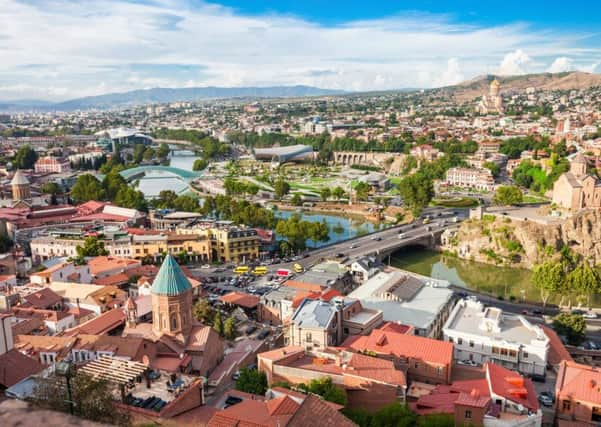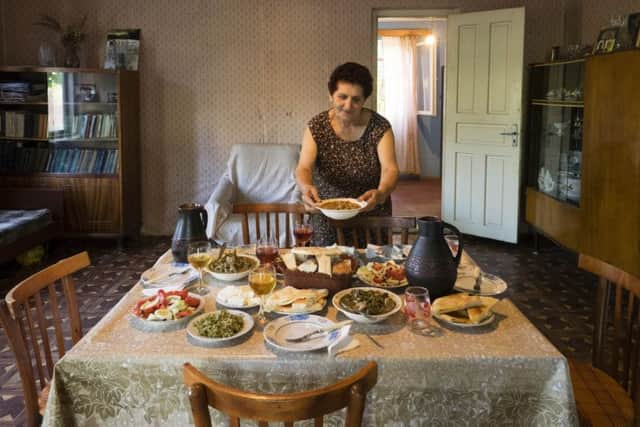Travel: Georgia


It’s early summer and the trees lining central Tbilisi’s residential streets offer cooling shade from the high sun. Walking through the picturesque old town I’m always reminded of Alexandre Dumas’s colourful descriptions of the city as it was in the 1850s. I love imagining the hilly lanes near the Persian baths crowded with camels, and the costumed people from distant lands leading mules packed with silks and spices into the caravanserais.
The spice traders and their camels may be long gone but some of that exoticism endures in Tbilisi’s older districts of wooden houses with fretwork balconies and grand – though slightly crumbling – villas. They offer an exciting contrast to the modern structures by international architects that now punctuate the city on both sides of the Kura River.
Advertisement
Hide AdTbilisi was founded in the late 5th century, situated here for the natural warm springs that King Vakhtang of Iberia came upon when he was hunting. Over the centuries the city has been razed and rebuilt many times but now, in despite being invaded by Russian less than ten years ago, Tbilisi is evolving quickly, flourishing with a new crop of cafés and restaurants and a relaxed, friendly atmosphere that reminds me of Greenwich Village and Palermo.


Starting in the capital, and with at least one week to spend in Georgia, it’s possible to travel widely through the varied landscapes of this modestly sized country (it’s the same area as Scotland, a quarter of Italy), nestled between the Greater and Lesser Caucasus Mountains and the Black Sea. To the north are the highlands of Kazbegi or Svaneti, where small stone villages surrounded by grazing pastures huddle beneath glacier peaks. Svaneti is popular with lovers of the outdoors and is worth visiting for the tall medieval defence towers that dot the landscape, similar in purpose to those in Bologna and San Gimignano.
To the south is the fascinating valley of the Mtkvari River, where the 12th-century Queen Tamara (also known as “King Tamar”) laid waste to eastern invaders from the safety of the hidden cave-city, Vardzia (now one of Georgia’s many Unesco sites). If the large eastern region, Kakheti, has a hot dry climate that’s perfect for producing the wine grapes Georgia is so admired for, its western counterparts offer subtropical lowlands better suited to hazelnuts and tea; the regions of Samegrelo, Guria and Adjara form the country’s border with the Black Sea.
The easiest way to travel is to hire a car and driver, usually for less than it costs to rent the car alone. That way you can relax and admire the views – and the wine. Georgia’s ancient and unique wine-making tradition sees the grapes placed in large terracotta jars that have been buried in the ground where they are free to ferment and become wine in what the Georgians describe as the “mother’s embrace”. The qvevri, as these oversized coil pots are called in Georgia, are made by hand by what are now merely a handful of master potters who have carried this know-how, from father to son for at least 8,000 years. Unlike the mass-produced wine that is made on an industrial scale by large wine companies, and whose clients are mostly the former Soviet bloc countries, the qvevri wines are produced mainly by families whose bottle output numbers in the low thousands. These vignerons make hospitable hosts; many open their doors for tastings and meals. The qvevri wines are attracting serious wine lovers from around the world to Georgia to visit the birthplace of wine and sample some of the country’s 525 varieties of native grapes.
If wine is considered a staple at the Georgian table, it’s because it forms such an integral part of the Georgian feast, or supra. At a supra, the guests may number from 4 to 40 or more, but the eating style is always the same. Before the diners take their seats the table is laden with prepared dishes, starting with the cold foods. These usually include aubergines stuffed with herbed walnut paste, foraged greens, wild mushrooms, fermented acacia blossoms, roasted quail, sliced cheeses, cucumber and tomato salad and other local specialities. Each diner has a small plate and is encouraged to help themselves from the serving dishes, taking modest amounts but going back for more as they wish. Meanwhile the hot dishes begin to be added to the cold, with the cheese-filled bread, khachapuri, taking pride of place alongside steaming dumplings; stewed lamb with sour plums and barbecued meats bring up the rear. The abundant, colourful food is vibrant with fresh herbs, from opal basil to tarragon, dill and coriander.


All this eating is of course accompanied by wine, and nothing goes as well with this wide array of tastes than the so-called orange wines made in qvevri from long macerations of white grapes such as Rkatsiteli, Mtsvane and Tsolikouri.
Advertisement
Hide AdThe most important personage at a supra is the tamada, each feast’s informally appointed toastmaster. His – or, occasionally now, her – role is to bring a structure to the proceedings. “It’s the tamada’s responsibility to act as master of ceremonies and be a wonderful host,” explains Luarsab Togonidze, one of Tbilisi’s most celebrated tamadas. “Georgian toasts follow a prescribed order, and may be given for many subjects: God, peace, family and guests are constants. It’s important too to be attentive to how much the guests are drinking, and to pace the wine.” I’m always impressed by how a good tamada makes everyone at the table feel special. It is an unforgettable experience.
FACTBOX
Georgian Airways (www.georgian-airways.com) and Wizzair (wizzair.com) are now operating some direct flights to Tbilisi and Kutaisi (in western Georgia) to supplement the flights via Istanbul of Turkish Airlines (www.turkishairlines.com). See websites for prices.
Advertisement
Hide AdFor information about wine tours: www.travellivingroots.com, www.georgia.travel
Carla Capalbo is an award-winning food and wine writer and photographer. Her latest book, Tasting Georgia: A food and wine journey in the Caucasus, is published by Pallas Athene, £29.99, hardback